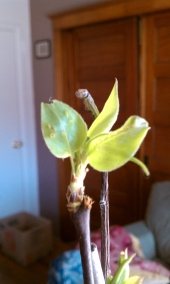








Seed the Mind, Harvest Ideas.
http://farmwhisperer.com













There is, as yet, no cure for fire blight and the best way to deal with the infection is to remove infected stems and branches cutting no less than 8 inches up from the infected area. Because the bacteria are so easily transmitted, care should be taken in disposing of infected plant material. Either burn or discard in the trash. Do not leave infected material where the bacteria might be spread to surrounding bushes or trees. Care should also be taken with tools which have come into contact with the bacteria. Tools can be sterilized in an alcohol solution (three parts denatured alcohol to one part water). Diluted household bleach can also be used (one part bleach to nine parts water) as long as the tools are wiped dry after disinfecting to prevent corrosion.
A variety of bactericides have been developed to combat fire blight, many of the most common containing streptomycin sulphate. Check with your local garden or landscape centre for details and remember to follow the instructions carefully.
Seed the Mind, Harvest Ideas.
http://farmwhisperer.com




"the qualities of these bacteria, like the heat of the sun, electricity, or the qualities of metals, are part of the storehouse of knowledge of all men. They are manifestations of the laws of nature, free to all men and reserved exclusively to none." SCOTUS, Funk Bros. Seed Co. v. Kale Inoculant Co.








Emerson White wrote:
They weren't very good at sterilizing surgical instruments in olden times, I think that is why they stopped using thymol. Unless you want to get into fractional distillation (and you don't) you are much better with some good ole moonshine and a match, dip the metal cutting edge then light it up.
"the qualities of these bacteria, like the heat of the sun, electricity, or the qualities of metals, are part of the storehouse of knowledge of all men. They are manifestations of the laws of nature, free to all men and reserved exclusively to none." SCOTUS, Funk Bros. Seed Co. v. Kale Inoculant Co.





 2
2




 2
2




“The most important decision we make is whether we believe we live in a friendly or hostile universe.”― Albert Einstein

|
Bras cause cancer. And tiny ads:
Rocket Mass Heater Resources Wiki
https://permies.com/w/rmh-resources
|




